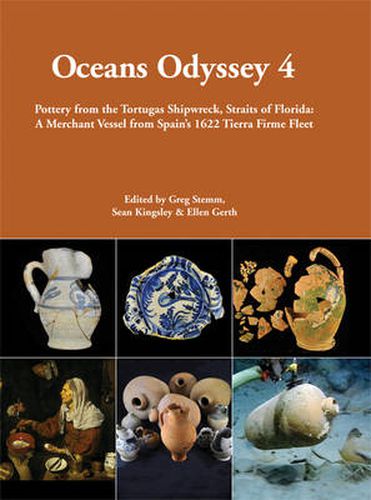Readings Newsletter
Become a Readings Member to make your shopping experience even easier.
Sign in or sign up for free!
You’re not far away from qualifying for FREE standard shipping within Australia
You’ve qualified for FREE standard shipping within Australia
The cart is loading…






The Tortugas shipwreck excavated at a depth of 405 meters in the Straits of Florida contained a major collection of 3,800 intact and fragmentary olive jars, tablewares, cooking vessels and tobacco pipes. Identified as the Portuguese-built and Spanish-operated 117-ton Buen Jesus y Nuestra Senora del Rosario, the ship’s Seville dominated tablewares are a revealing index of unchanged cultural tastes and continued production at the end of Spain’s Golden Age. For cooking the crew relied on Afro-Caribbean colonoware, possibly the first recorded archaeological evidence of maritime slavery in the Americas fleets. Two tin-glazed plates painted with papal coat of arms - the Keys of Heaven and triple crown - may have been used by Spain-bound clergymen from the newly formed Sacred Congregation of the Propagation of the Faith. Samples of all ceramics were subjected to Inductively-Coupled Plasma Spectrometry (ICPS) analysis to determine vessel origins.
Six chapters focus on the tablewares, tin-glazed papal plates, Afro-Caribbean cooking wares, the olive jars, Inductively-Coupled Plasma Spectrometry results, and a study of how the pottery reflects Spanish colonial economic models, also compared to Roman and medieval structures.
$9.00 standard shipping within Australia
FREE standard shipping within Australia for orders over $100.00
Express & International shipping calculated at checkout
Stock availability can be subject to change without notice. We recommend calling the shop or contacting our online team to check availability of low stock items. Please see our Shopping Online page for more details.
The Tortugas shipwreck excavated at a depth of 405 meters in the Straits of Florida contained a major collection of 3,800 intact and fragmentary olive jars, tablewares, cooking vessels and tobacco pipes. Identified as the Portuguese-built and Spanish-operated 117-ton Buen Jesus y Nuestra Senora del Rosario, the ship’s Seville dominated tablewares are a revealing index of unchanged cultural tastes and continued production at the end of Spain’s Golden Age. For cooking the crew relied on Afro-Caribbean colonoware, possibly the first recorded archaeological evidence of maritime slavery in the Americas fleets. Two tin-glazed plates painted with papal coat of arms - the Keys of Heaven and triple crown - may have been used by Spain-bound clergymen from the newly formed Sacred Congregation of the Propagation of the Faith. Samples of all ceramics were subjected to Inductively-Coupled Plasma Spectrometry (ICPS) analysis to determine vessel origins.
Six chapters focus on the tablewares, tin-glazed papal plates, Afro-Caribbean cooking wares, the olive jars, Inductively-Coupled Plasma Spectrometry results, and a study of how the pottery reflects Spanish colonial economic models, also compared to Roman and medieval structures.